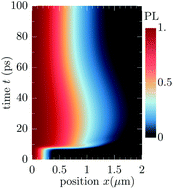Negative effective excitonic diffusion in monolayer transition metal dichalcogenides†
Abstract
While exciton relaxation in monolayers of transition metal dichalcogenides (TMDs) has been intensively studied, spatial exciton diffusion has received only a little attention – in spite of being a key process for optoelectronics and having already shown interesting unconventional behaviours (e.g. spatial halos). Here, we study the spatiotemporal dynamics in TMD monolayers and track optically excited excitons in time, momentum, and space. In particular, we investigate the temperature-dependent exciton diffusion including the remarkable exciton landscape constituted by bright and dark states. Based on a fully quantum mechanical approach, we show at low temperatures an unexpected negative effective diffusion characterized by a shrinking of the spatial exciton distributions. This phenomenon can be traced back to the existence of dark exciton states in TMD monolayers and is a result of an interplay between spatial exciton diffusion and intervalley exciton–phonon scattering.



 Please wait while we load your content...
Please wait while we load your content...